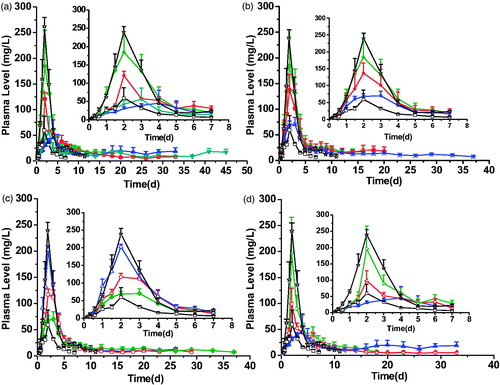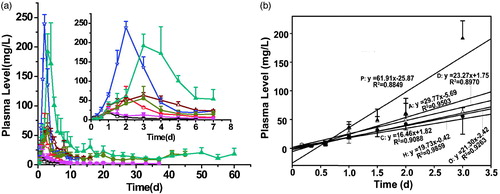Figures & data
Table 1. SAIB-based in situ forming formulations and dosage regimen for FITC-labeled ROP (FROP) or mono-PEGylated ROPs (FMP-R) (n = 3).
Table 2. Pharmacokinetic parameters of Table FootnoteFROP released from 90%SAIB/10% solvent. (n = 3).
Figure 1. Plasma FROP concentration-time profiles achieved by the SAIB/solvent systems. (□) aqueous solution 1, (☆) aqueous solution 2, (◆) SAIB/ethanol (9:1, w/w), (▲) SAIB/NMP (9:1, w/w), (▼) SAIB/TA (9:1, w/w), (•) SAIB/BB (9:1, w/w). The dose for all the SAIB/solvent systems was 200 mg/kg, while those for the control aqueous solutions 1 and 2 were 15 and 50 mg/kg, respectively. FROP: FITC-labeled radix ophiopogonis polysaccharide; FITC: fluorescein isothiocyanate; SAIB: sucrose acetate isobutyrate; BB: benzyl benzoate; NMP: N-methyl-2-pyrrolidone; TA: triacetin.

Figure 2. Plasma FMP30k-R concentration-time profiles achieved by the SAIB/PLGA(PLA)/NMP systems (a, profiles achieved by the SAIB/PLGA/NMP systems with different molecular weights of PLGA; b, profiles achieved by the SAIB/PLGA10k/NMP systems with different ratio; c, profiles achieved by the different SAIB/additive/solvent systems; and d, profiles achieved by the SAIB/PLGA40k/NMP systems with different ratio.). (□) aqueous solution 3, (☆) aqueous solution 4, (◆) SAIB/PLGA10k/NMP (5:2:3, w/w/w), (•) SAIB/PLGA30k/NMP (4:2:4, w/w/w), (▲)SAIB/PLGA40k/NMP (4:2:4, w/w/w), (▼) SAIB/PLGA50k/NMP (3.5:2:4.5, w/w/w), (⬡) SAIB/PLGA10k/NMP (4.5:2.5:3, w/w/w), (※) SAIB/PLGA10k/NMP (4:3:3, w/w/w), (^) SAIB/PLA10k/NMP (4:3:3, w/w/w), (△)SAIB/PLA10k/Ethanol (4:3:3, w/w/w), (◃) SAIB/PLGA40k/NMP (4.5:1.5:4, w/w/w), (▷)SAIB/PLGA40k/NMP (5:1:4, w/w/w). The dose for all the SAIB-based systems and aqueous solution 4 was 300 mg/kg, while that for the control aqueous solution 3 was 75 mg/kg. FMP30k-R: FITC-labeled 30 kDa PEG mono-modified ROP; SAIB: sucrose acetate isobutyrate; FITC: fluorescein isothiocyanate; PEG: polyethylene glycol; ROP: radix ophiopogonis polysaccharide; PLGA: poly(d,l-lactide-co-glycolide); PLA: polylactic acid; NMP: N-methyl-2- pyrrolidone; 10k, 10 kDa; 30k, 30 kDa; 40k, 40 kDa; and 50k, 50 kDa.

Table 3. Pharmacokinetic parameters of FMP-R released from SAIB/additives/solvent (n = 3).
Figure 3. Plasma FMP-R concentration-time profiles achieved by the SAIB/PLGA50k/NMP systems loaded with different molecular weight FMP-R. (□) Aqueous solution 5 (FMP20k-R), (^) Aqueous solution 3 (FMP30k-R), (☆) aqueous solution 4 (FMP30k-R), (△) aqueous solution 6 (FMP40k-R), (▪) SAIB/PLGA50k/NMP (3.5:2:4.5, w/w/w, FMP20k-R), (•) SAIB/PLGA50k/NMP (3.5:2:4.5, w/w/w,FMP30k-R), (▲) SAIB/PLGA50k/ NMP (3.5:2:4.5, w/w/w, FMP40k-R). The dose for all the SAIB-based systems and aqueous solution 4 was 300 mg/kg, while that for the control aqueous solutions 3, 5, and 6 was 75 mg/kg. FMP20k-R: FITC-labeled 20 kDa PEG mono-modified ROP; FMP30k-R: FITC-labeled 30 kDa PEG mono-modified ROP; FMP40k-R: FITC-labeled 40 kDa PEG mono-modified ROP; FITC: fluorescein isothiocyanate; PEG: polyethylene glycol; ROP: radix ophiopogonis polysaccharide; SAIB: sucrose acetate isobutyrate; PLGA: poly(d,l-lactide-co- glycolide); NMP: N-methyl-2-pyrrolidone; 50k, 50 kDa.

